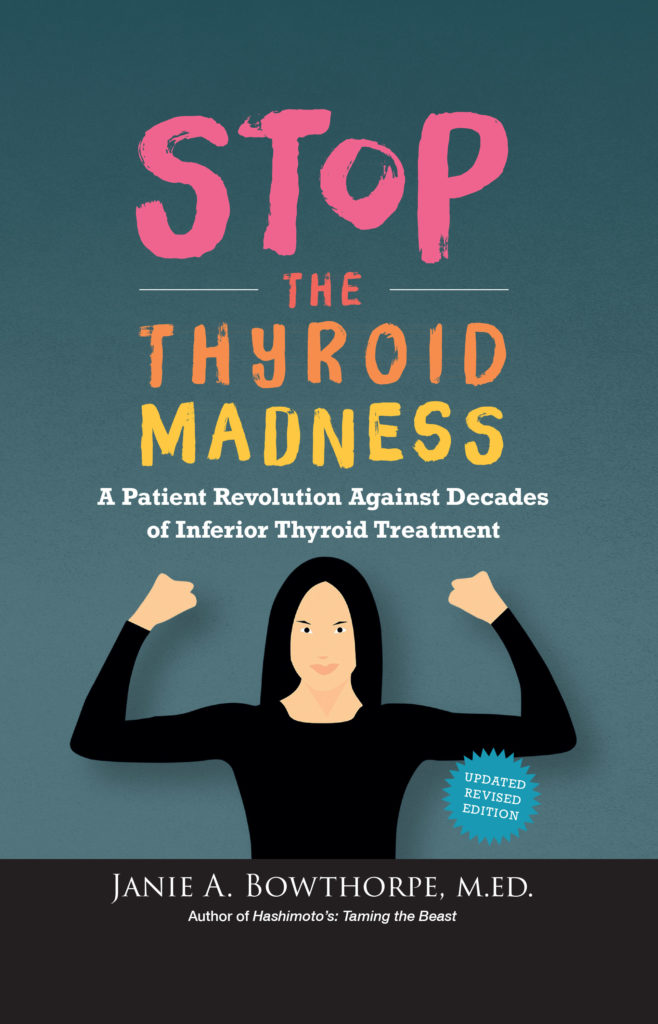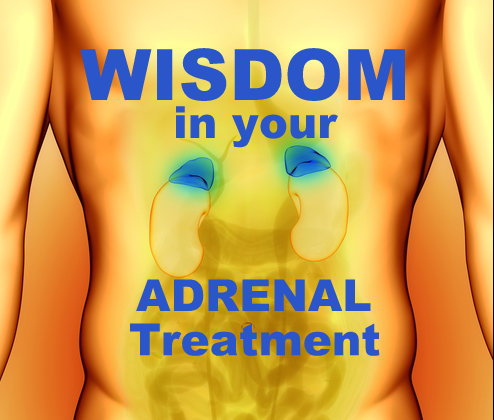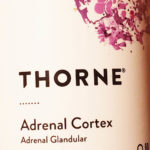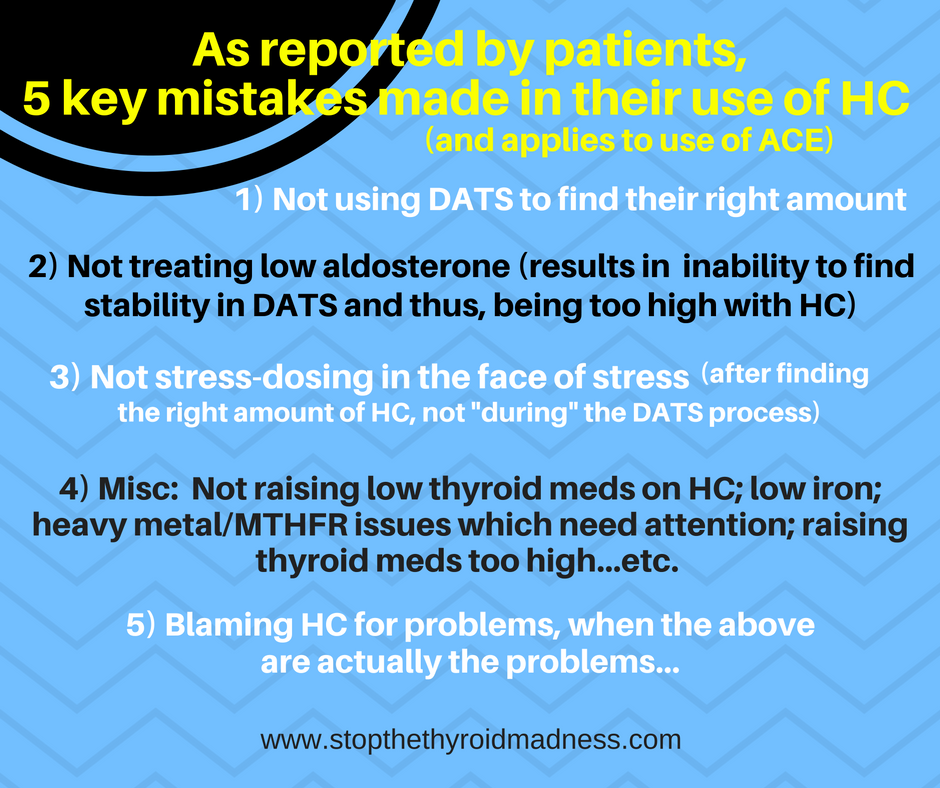The following represents adrenal gems in patient-reported experiences and wisdom concerning their adrenals and issues. Especially “adrenal fatigue”. The best information you are going to get for treatment is in Chapters 5 & 6 in the updated revision STTM book (aka STTM I) ~Janie, hypothyroid patient and site creator
TESTING
1) Patients have learned it is never wise to guess whether we have low cortisol, or a mix of highs and lows, or even just highs, even if we “think” we do!
With our adrenals, some symptoms of high cortisol can be similar to symptoms of low cortisol, patients noted repeatedly. So we could end up treating the wrong thing. Plus there are different variations of an adrenal problem which require different treatments–see below.
2) The 4-point saliva cortisol is the best way to find out for most hypothyroid patients, NOT blood testing, patients discovered.
Blood testing is measuring the combination of bound and unbound cortisol, of which 80% or higher is bound and unusable! So patients saw they could look high when they were actually low, cellularly. This has happened to a lot of patients!
Plus saliva testing will test you at four key times in a 24 hour period, measuring our cellular levels, which is key. They even knew saliva was the way to go in 1983!
Click on the graphic to your left to order your own saliva cortisol test. Or here.
Remember not to eat right before any of your four saliva vial spits. Eating will either push cortisol too high, or if you already have low cortisol, can stress the adrenals even more.)
Read more here about saliva testing. If you suspect you might have Addison’s–a problem directly in your adrenals (which most of our adrenal problems are not), go here.
3) Treatment for adrenal results in hypothyroid patients should be based on saliva testing that is no more than three months old, as learned the hard way by thyroid patients.
Patients report learning the hard way that cortisol levels can change. So what was true three or more months ago, may not be the same now (even though it will be problematic), so you’d be treating the wrong thing today that was true then.
4) Saliva results have nothing to do with falling in the normal range, patients observed!
Patients discovered, upon viewing the saliva results of many others who did not have a cortisol problem, that the results have to do with “where” they fall in ranges. See where folks fall when their cortisol levels are ideal here.
DIFFERENT KINDS OF ADRENAL ISSUES AS REVEALED BY SALIVA TESTING…and how we learned to treat them
1) High cortisol:
High cortisol results are defined as “two or more results together which are too high”. Examples include high morning and high noon….or high afternoon and high bedtime. Often the others are close to where they should be or too low. But in the early stage of adrenal problems, all could be high.
Excessive progesterone supplementation has caused high cortisol in some women, but so can other issues like continued hypothyroidism, excess stress, active Lyme disease, etc. High cortisol can block the conversion of T4 to T3, favoring conversion to RT3 and putting you further into a hypothyroid state. See the RT3 information in the revised STTM book for more info, as well.
***Read the last chapter of the STTM II book which does an EXCELLENT job explaining why our cortisol first goes high…then why it can fall to low, by Dr. Laura Stone, MD. A highly recommended chapter!!
TREATMENT: Patients report using certain supplements like Holy Basil, zinc, Phosphatidylserine, etc to help lower the high results while correcting what was causing it. The latter is important. In turn, by lowering high cortisol, the other low cortisol results (if you have some lows) can come up a bit, though sometimes patients choose to use a cortisol supplement for a short time during those low times. The former supplements are not for long term and each person should look them up to make sure there’s nothing in any that would be a problem for them. Work with your doctor.
2) A see-saw mix of highs and lows:
Picture up, down, up, down or vice-versa. An example is a morning result far over the range, very low noon result, overly high afternoon result. Picture a see-saw, which is different than having two highs in a row. This see-saw pattern is more the pattern of healthy adrenal function but one that is reacting to stress.
Both high cortisol and low cortisol can cause problems raising Natural Desiccated Thyroid or T3, first causing hyper-like symptoms from excess adrenaline, then causing too much RT3.
TREATMENT: This is where you do need the updated STTM book. Many supplements used are described in Chapter 15 of the STTM 1 book. Also see pages 106 – 108. This book is a hypothyroid of any cause and adrenal CLASSIC.
3) Low Cortisol

https://laughinggrapepublishing.com
Low Cortisol can happen with one low, two or three lows, or all four lows on saliva. This is where the term “adrenal fatigue” comes into play, though it could also be called adrenal insufficiency or hypocortisolism (See the excellent Chapter 15 in the STTM II book–a highly recommended chapter by a practitioner!)
TREATMENT: This is where you need to study chapters 5 and 6 of the updated revision STTM book. Chapter 6 also explains HOW we dose them, the Daily Average Temps, about stress dosing and more.
Cortisol is needed to allow T3 to enter our cells and to finally allow us to get out of our hypothyroid state–the latter a strong reason many have adrenal issues in the first place.
Low cortisol is not treated as well with adaptogens, patients report. Adaptogens work far better with the stress response of healthy adrenal function, such as high, low, high, low or vice versa on a saliva test. Yes, some report they feel a bit better having very low cortisol and using adaptogens….but they continue to have that low cortisol, which will prevent you from getting out of your hypothyroid state.
POINTS OF INTEREST
1) Licorice Root (If you have slightly low cortisol at “one” particular time–this is not for those who have several times of low cortisol or seriously low cortisol)
Licorice root, with its glycyrrhizin content, is used to make slightly low cortisol more useable i.e. it prevents your liver from breaking down cortisol as much. Capsules or tea is used. It can’t be used long term, as it tends to raise blood pressure in some folks because it lowers potassium. But short term use has worked well for many. Or taking potassium at the same time might work.
2) Avoiding “Adrenal glandular” products
“Adrenal glandulars” are NOT the same as “Adrenal cortex”. Glandulars give you the entire gland, and know why that can be a problem?? Adrenal glandulars are BOTH the medulla and cortex. The cortex contains cortisol, yes, but the medulla contains adrenaline. Oops. If you have an adrenal problem, you most likely already make too much.
EXCEPTION: Thorne’s Adrenal Cortex (to the right) added “Adrenal glandular” underneath Adrenal Cortex. Yes, the cortex is part of the “gland”, but in this case, it is NOT what products call adrenal glandular. So you are fine with what you see to the right.
3) Using Hydrocortisone when three or more times are seriously low
It’s extremely important to study Chapter 6 in the updated revised STTM book about what patients report learning in their successful use of HC. Find a good doctor to work with on all this!
MISTAKES PATIENTS MAKE WITH THEIR ADRENALS
- Failing to do saliva cortisol testing: read all four points under TESTING above. Patients have repeatedly found it unwise to guess, or to even go by older saliva results. Blood cortisol has been a failure since it’s measuring both bound and unbound and implies you are okay or high when you are not.
- Using ACE or glandular when they didn’t need it: common when someone didn’t do saliva testing and is guessing. Or, if saliva does prove low cortisol, it’s too low for any of these to do the job well.
- Using Adrenal Glandulars for low cortisol when one already makes too much adrenaline: Unless stated otherwise, glandulars contains adrenaline, and if a patient has found themselves with hyper-like symptoms–higher heartrate, palps, anxiety–glandulars can end up contributing because of their adrenaline content!
- Failing to do their Daily Average Temps when using HC: This is a huge mistake, patients report, resulting is staying on too low a dose, or going too high. See The Temperature Test on page 82 of revised STTM book.
MISTAKES PATIENTS MAKE IN THEIR USE OF HYDROCORTISONE (HC) or ADRENAL CORTEX
To read more about adrenals, go here.
If you suspect other causes of low cortisol that aren’t due to being on T4, being underdosed, held hostage to the TSH, go here.
To order the updated revision STTM book with its two excellent chapters on adrenals, go here. Read, read, read! Your knowledge is important in working with your doctor.
**Interesting information about your Circadian Rhythm: Cortisol levels reach lowest levels at around midnight, levels start to rise at around 02:00 to 03:00 and reach a peak at around 08:30 am. Cortisol levels then slowly decrease back to the nadir to complete the cycle over 24 hours. https://www.ncbi.nlm.nih.gov/pmc/articles/PMC3475279/
Come on over and “Like” the Stop the Thyroid Madness LLC Facebook page for daily tips and information.
Important note: STTM is an information-only site based on what many patients have reported in their treatment. This is not meant to replace the doctor to patient relationship or guidance, and you agree to that by reading this information-only website. See the Disclaimer and Terms of Use.
Important notes: All the information on this website is copyrighted. STTM is an information-only site based on what many patients worldwide have reported in their treatment and wisdom over the years. This is not to be taken as personal medical advice, nor to replace a relationship with your doctor. By reading this information-only website, you take full responsibility for what you choose to do with the information on STTM or its outcomes. See the Disclaimer and Terms of Use.



